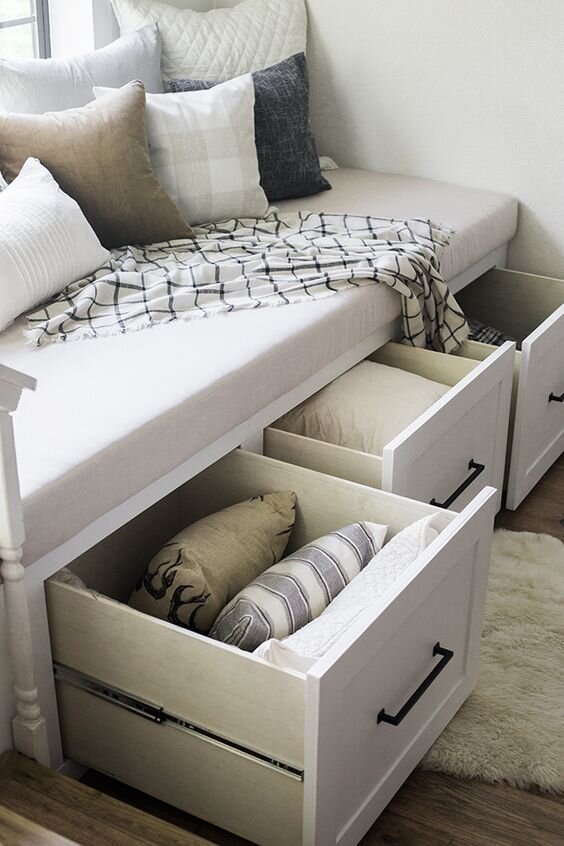Small Spaces with Big Style (Part 1)
Welcome to my first lifestyle and design blog. Here, I will show how to design the small spaces in your home. These simple principles will maximize and utilize your smallest rooms to make the biggest statements in your home. Let’s begin with my top 5:
1. Bring your largest pieces to the perimeter of your room
Whether you are rearranging your existing furniture or starting with a clean slate by purchasing all new furniture and décor, you will want to think big picture, first. We do this by starting with what your largest pieces are or will be. In most small spaces, these items will most likely be a couple of chairs, a loveseat, a bed, and case good (i.e. end table, bookcase, dresser or some type of storage piece.) You will want to rearrange these largest pieces towards the perimeter of the space. Do not place very large pieces in the middle of a room. Placing large pieces, like an oversized coffee table, in the middle will make a small room feel like a cluttered space and makes it difficult to move around. Small round coffee tables work because the curved shape can be easily moved around. When I use a set of chairs as my staple pieces, I like to position them towards each other to make for a more intimate conversational setting.
2. Multi-purpose pieces.
In order to best utilize small spaces in a home, they need to be both functional and well designed. Incorporate at least one piece that has both beauty and function. Examples of pieces that double for both form and function include: beds with storage, baskets, trunks or benches with lift storage, end tables with a lower shelf or bookcases. These pieces showcase your style while functioning with hidden places to store items you don’t want to feature.
3. Light.
Obviously, if you have windows to bring natural light in, that is always ideal but don’t sweat it if you don’t. Light can be introduced through many sources. The most obvious would be table lamps with daylight bulbs. I will be discussing different types of light bulbs in a future blog but a good rule of thumb is to always look for the lamps that have the highest useable lumens (or brightness) you can use to illuminate your space. Notice I didn’t say wattage. There are many energy efficient bulbs that can illuminate without high wattage.
Even in small rooms, table lamps – delivering their high-lumen output – can brighten any room. For instance, if you have a small sofa table or buffet in the room you can flank the top with a lamp on each end. If you feel like splurging, chandeliers, flush mount lights and recessed lighting on dimmers are some of my favorite things to add to any room. This gives you the ability to bring maximum light in while allowing you to control the amount of light needed in the room at any given time.
Design tip: try to steer clear of bulky floor lamps in a small room as that can take up unnecessary floor space that can be used for different design elements that we will discuss later.
4. Mirrors
Mirrors are to a small space what Instagram is to the Kardashians. They are necessary to make it feel bigger. Mirrors reflect the natural and synthetic light in a room to brighten it up (another way to bring in light) so you don’t feel closed in. They magnify small spaces while giving the illusion that the room is much bigger than it actually is.
5. Utilize height
I can’t express this one enough. When you have a small room, it is imperative to use every architectural element you can. The vertical dimension of a room is no exception. There are several ways you can do this in a room:
Mount drapery rods all the way up the wall (only about an inch from the ceiling). Hanging drapery from ceiling to floor gives the illusion that your room is taller than it actually is.
Floating shelves. This handy décor element allows you to build up a wall. What I mean by that is, you can stack décor again drawing your eye upwards. Often, I like to install 3 floating shelves up the wall stacked in line with each other to display well-curated décor. Items to display on shelving can be museum stands, vases or tall topiaries. Your top shelf should have a tall décor piece (you can stack books to get the height of a piece if it’s not tall enough. This trick will raise your eye up towards the ceiling and use the full height of the wall.
Large wall art. Don’t be afraid to use large art to fill a wall especially if it is your only art in the room. Wall art can be your statement piece(s). I’ve used a piece as wide and tall as the wall directly above loveseats to pull a whole style of a room together. This works especially well if there are striking and bold colors used. Don’t be afraid to make that statement.
I have more, but I wanted to start with these five principles. Go ahead, transform that cluttered den. You will be amazed at what a little height and light can do in a space. Until next time!








